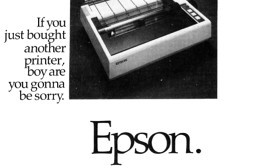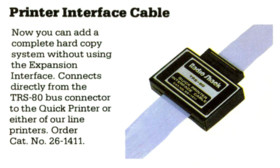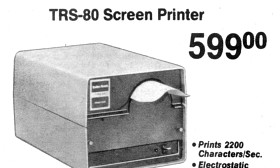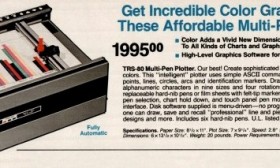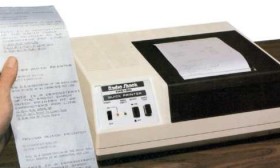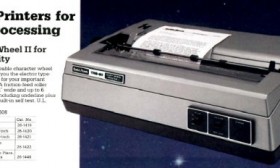Articles in the "Printers" Category
The Epson MX-80 was one of the first very successful consumer dot-matrix printers. It was introduced in October 1980 by Shinshu Seiki Co., Ltd. (later known as Epson Corporation) of Nagano, Japan. The Epson MX-80 was the best selling printer in the United States and Japan and became synonymous with dot-matrix printers.
The printer control language used by the MX-80 (later known as ESC/P) became an important standard that was supported by other printer manufacturers. It was a rare TRS-80 program that could print and didn’t support the Epson MX-80.
(Read more...)
One of the limitations of the cassette-based TRS-80 Model I was that it had no printer port. There were many cassette programs designed to use a printer, such as Electric Pencil and Scripsit, but no simple way to add one. Only a few Radio Shack printers were designed to connect to a cassette-based Model I directly.
The usual approach to adding a printer was to buy a Radio Shack Expansion Interface. In addition to providing extra memory and a floppy disk controller, the Expansion Interface also added a printer port. But a fully equipped Expansion Interface cost more than a Model I itself, and a unit with no memory still cost $299.00. Another option was a lighter-weight third-party Expansion Interface, such as the Microtek MT-32 or Exatron MM+. But this was still overkill if all you wanted was a printer.
(Read more...)
The TRS-80 Screen Printer (catalog number 26-1151) was the first printer Radio Shack sold for the TRS-80 Model I. It was introduced in March 1978 for $599.00. As the name suggested, the Screen Printer could print only one thing: the contents of the TRS-80 screen.
The Screen Printer was a very compact unit, not much larger than the four-inch wide “electrosensitive paper” that it printed on. It had a “PRINT command switch” on the front of the unit. When that switch was pressed, the entire contents of the TRS-80 screen (including graphics) were printed out on the aluminum-coated paper in around two seconds.
Unlike most other Radio Shack printers, the Screen Printer didn’t connect to the line printer port on the Radio Shack Expansion Interface. The Screen Printer connected directly to the bus card-edge connector on the Model I or on the Expansion Interface (also known as the Screen Printer connector).
(Read more...)
The TRS-80 Multi-Pen Plotter (catalog number 26-1191) was similar to the earlier TRS-80 Plotter/Printer (catalog number 26-1190), but offered one important new feature: the ability to print in color. Described as an “intelligent plotter,” the Multi-Pen Plotter used replaceable colored pens to print on paper or transparencies. Even at a price of $1995.00, the Multi-Pen Plotter was cheaper than many other color output alternatives available at the time. In fact, the catalog description states that the Plotter “brings an affordable price to color graphics!”
(Read more...)
The TRS-80 Quick Printer (catalog number 26-1153) was an early TRS-80 printer sold by Radio Shack. Introduced in 1978 for a price of $499.00, the Quick Printer was actually a rebranded Centronics Microprinter P1.
Unlike the more common dot-matrix or daisy-wheel printers (such as the TRS-80 Line Printer or the Daisy Wheel Printer II), the Quick Printer was an “electrostatic” printer that required special aluminum-coated paper. Radio Shack sold a package of three rolls of the 4.75″ wide “aluminized electrostatic spool paper” (catalog number 26-1405) for $16.95.
(Read more...)
The Daisy Wheel Printer II (catalog number 26-1158), more commonly known as the Daisy Wheel II, DW II, or DWP II, was the highest quality TRS-80 printer that Radio Shack sold. It was introduced in 1980 for a price of $1,960.00, although that was later raised to $1,995.00. Radio Shack featured the Daisy Wheel II in their catalog from 1981 to 1984 as their “best high-speed, formed-character printer.”
The Daisy Wheel II was a replacement for the rarely remembered Daisy Wheel Printer I (catalog number 26-1157), which was described by Ed Juge this way:
(Read more...)
